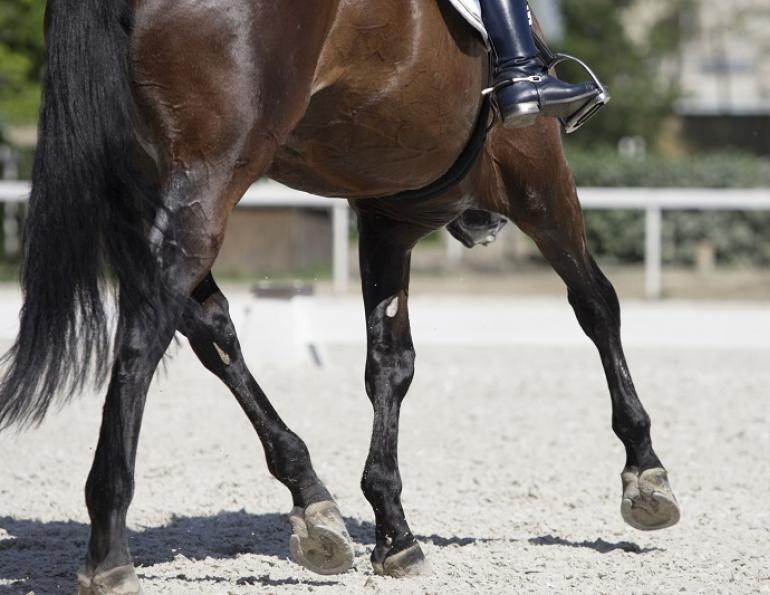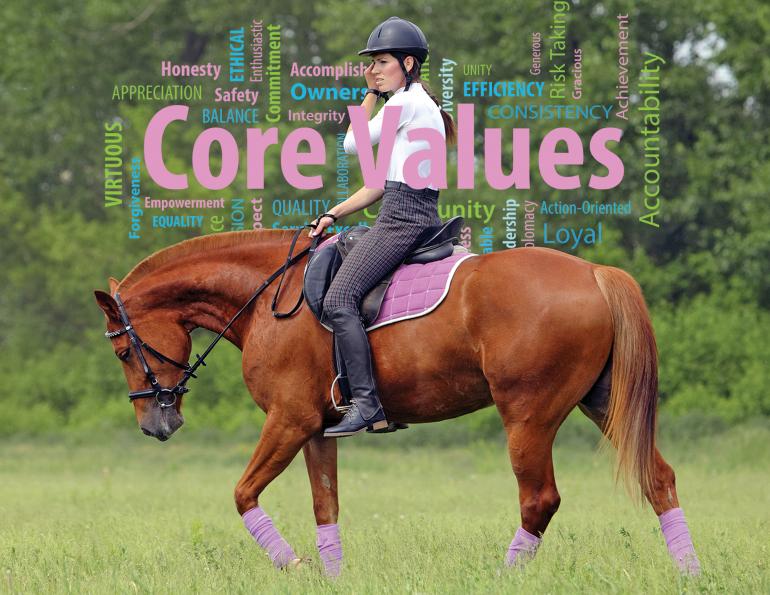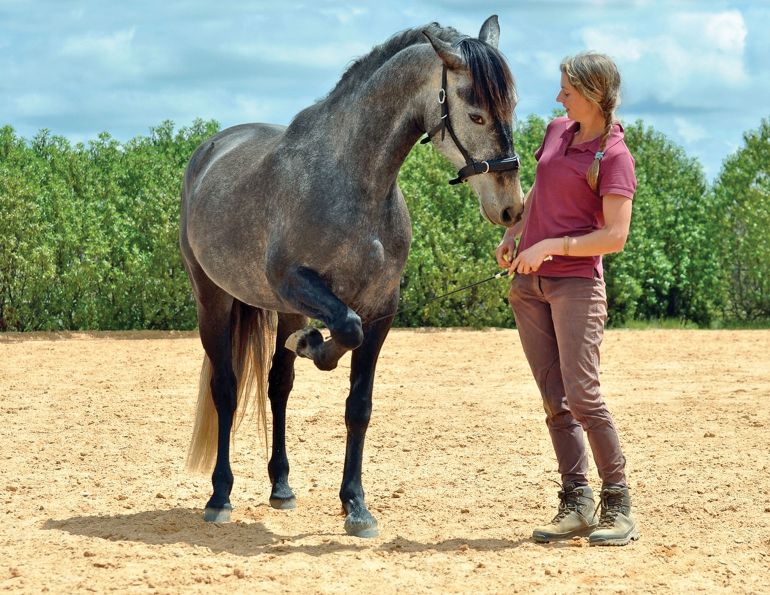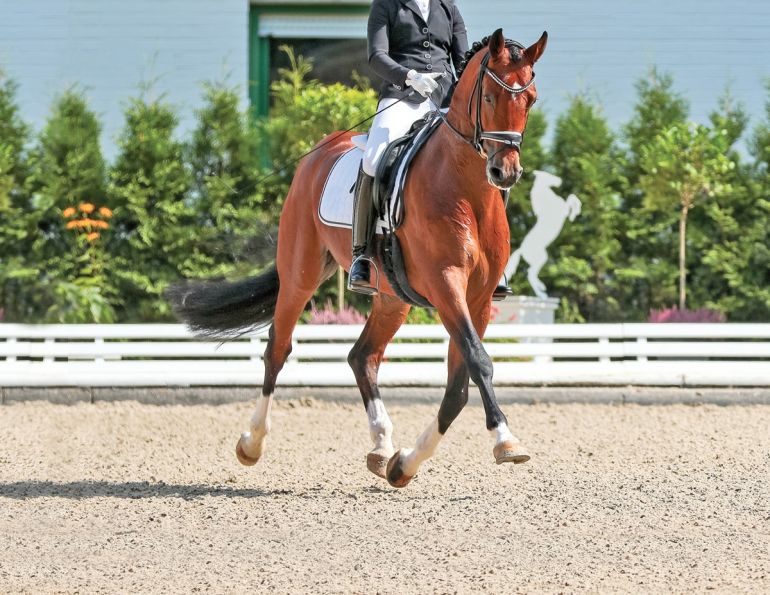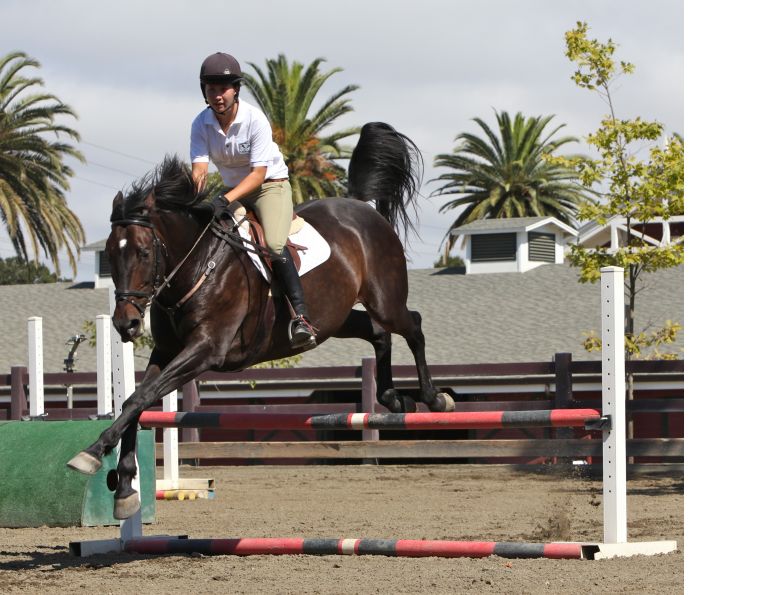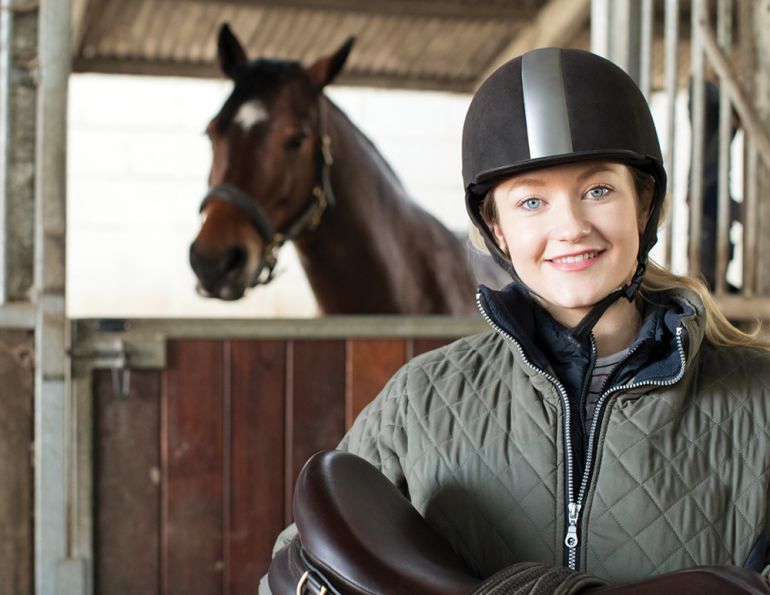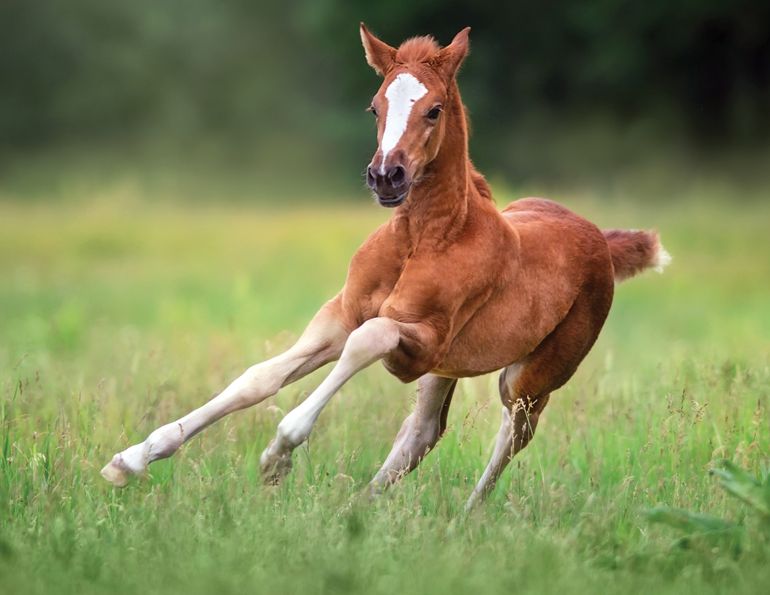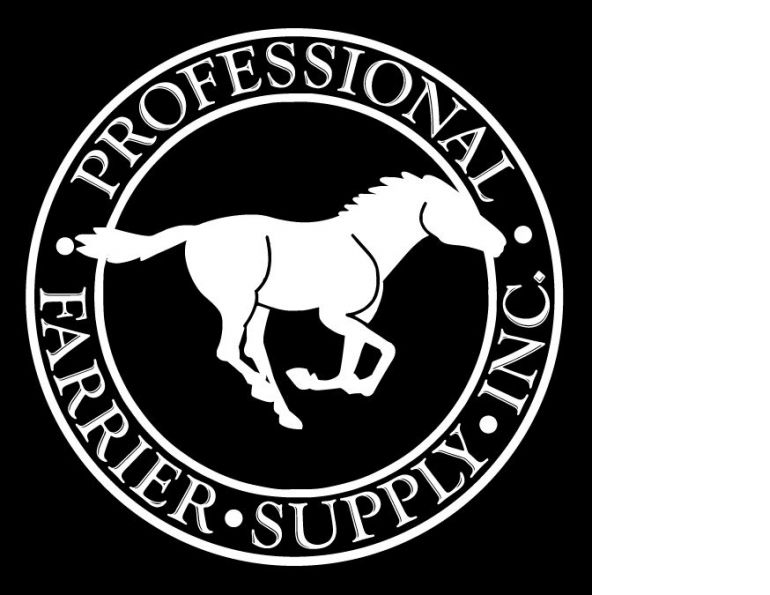By Margaret Evans
Riding arenas have the potential to be a rider’s dream. And just like the horse’s training regimen, it all comes down to the foundation.
There is some complex engineering involved in arena footing construction. If you are thinking of investing in building an arena, there are also some important factors to consider – factors that can influence either the advancement of your horse’s performance – or put him at risk for lameness or ligament/muscle injury. In addition, the degree to which you pay attention to dust control, especially in an indoor arena, will directly affect the quality of health of your horse, yourself, and others who also use the arena – not just riders and instructors, but onlookers, helpers, and others too.
“Regardless of the intended arena use, horse health should be the primary concern,” said Dave Heaton with Conterra Industries in Strathmore, Alberta. “For North Americans not living in southern USA, we live in one of the harshest environments to maintain consistent footing, whether indoor or out. If someone intends to build an arena, it should be considered a 10 to 20 year investment.”
To an unseasoned eye, a hogfuel/woodchip arena or one with a sandy surface may at first look like the perfect entry point to start training. But woodchips can induce slipping, while certain sands can induce tripping. The real place to start for that perfect arena is in what lies beneath.
“Your base is the most important thing,” said Alex von Hauff with Strathcona Ventures in Sherwood Park, Alberta. “You can spend a million dollars on the base and $5,000 on sand and you’ll be happy. If you spend $5,000 on the base and a million on sand, you’ll always be unhappy. Spend most of your money on your base and drainage.”
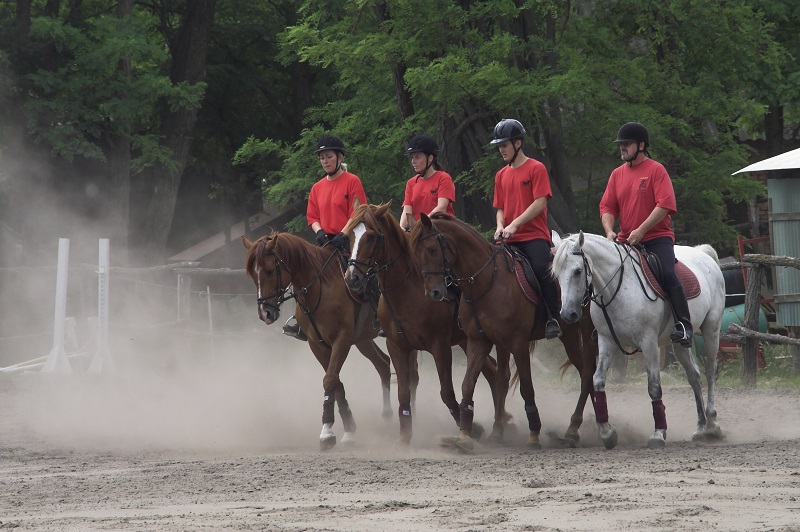
The amount of dust in your arena will impact the health of horse and rider, and everyone else who uses the ring.
The three primary considerations for arena placement are location on your property in relation to ground water, access to that water for watering the arena as part of its regular maintenance, and access to the site for trucks and equipment. Depending on your chosen riding discipline, your arena must provide stable, secure footing that allows the horse to transition in and out of movements. You must have access to sufficient water and, if budget allows, a sprinkler system to water the arena for both dust control and before regular light harrowing, or grooming, to level it. And, of course, you must have the equipment for the regular maintenance needs for the expected life of the arena.
Related: Tips for a Healthy Hay Loft
“Drainage of your arena is very important,” said Christi Capozzi, sales and marketing coordinator with ReitenRight Equestrian Inc. “Poor drainage can lead to inconsistent footing that can cause injury to your horse or cause the horses to punch through the footing into the base and damage the base, which is an expensive fix. It is important to do your research, pick a location for your arena that promotes drainage, install a good drainage system and get your drainage right the first time.”
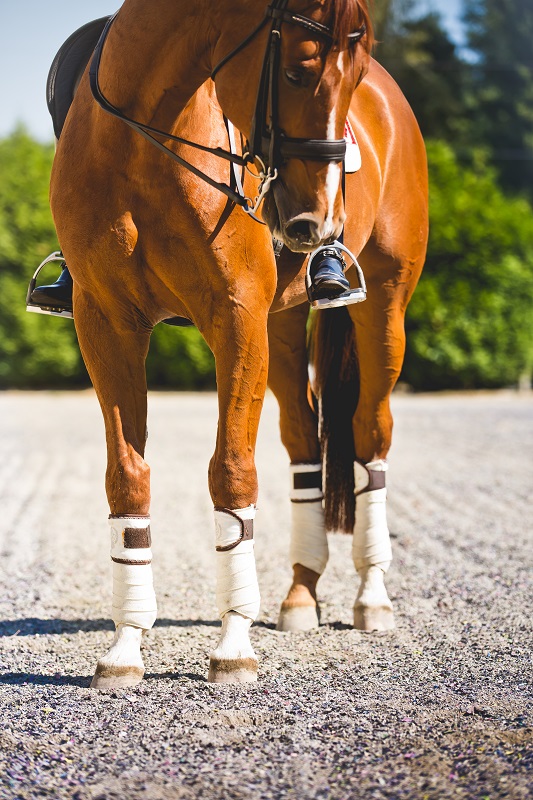
Understanding the biomechanical impact of horses ridden on different surfaces has become an exact and ongoing science. Photo: ReitenRight
Heaton said that the three main components of an arena are the base, the subsurface, and the top dressing.
“Bases are made mainly of clay,” he said. “How much base is dependent on arena placement, the local soil conditions, and your local environment. What works at one end of the country won’t work at the other. The subsurface is often discussed as an entity of its own. However, I believe a good subsurface is an extension of the top dressing, or footing. (But) many people want to use two different types of material, layering one on the other which, I believe in most cases, creates unstable ground. When a horse moves through good footing, the horse’s power is transferred through the top dressing down into the subsurface. The combination of these two entities gives a horse the stability and support required to confidently complete a movement.”
In today’s changing climate, environmental conditions could become increasingly challenging. Access to water may become all the more critical in regions where drought conditions are beginning earlier and extending longer. According to von Hauff, a 100 x 200 foot outdoor arena may need between 2,500 to 4,000 gallons (9,500 to 15,000 litres) of water a day and during the drought season upwards of 6,000 gallons (nearly 23,000 litres) a day. This poses the challenge of whether you will have access to that volume of water. Can you sustain and afford the amount of water you are going to need, or will it put pressure on your water source whether it is coming from your well, a ground water source, or a city aquifer? What restrictions might be in place during times of drought? But as von Hauff commented, if you can’t water your arena surface, it doesn’t bind. If it doesn’t bind you can’t use the arena.
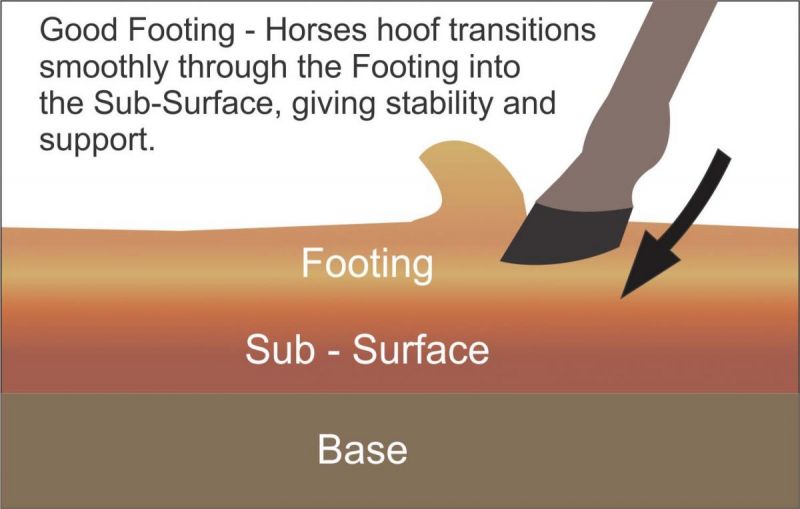
Illustrations courtesy of Conterra Industries

“The climate can be a major challenge, particularly if summers are hot and dry and winters are cold and wet,” said Dr. Sarah Jane Hobbs, Reader in Equine and Human Biomechanics with the University of Central Lancashire, UK, and lead author of the FEI Equine Surfaces White Paper. “Learning the best methods of maintenance throughout the year is important and maintaining the surface should also help to stop it becoming uneven. Riders should be paying attention to these changes as well. If the surface becomes very dry and deep for instance, a horse will have to work harder to jump a fence compared to when the surface is firmer and moist. Too much movement can cause slipping which causes overstrain of tendons and/or ligaments. If the surface gets too hard, then horses are likely to experience much greater forces much more quickly through their limbs which can cause damage to bone or cartilage over time.”
She added, though, that horses can be conditioned to many different types of surfaces as adaptations occur in their hard and soft tissues each time they are exercised. If riders consider the surface along with the current health and fitness of their horses together with the volume of exercise they intend to do on a daily basis, the adaptations should help to make them stronger and fitter rather than increasing injury risk.
Related: Air Quality in the Horse Barn
“The material composition of the surface is important as this will determine how it functions,” she said. “Having said that, though, different materials may function in similar ways. Many arena surfaces are sensitive to temperature and/or moisture and these can have a greater effect on how the surface functions than the surface materials themselves. Also, how the surface is used and how regularly it is maintained can influence how much the properties will vary across it.”
Hobbs wrote in the White Paper that the complex demands on a surface sometimes lead to contradictory needs to accommodate the range of loading and conditions for usage. One example given in the Paper is that the canter pirouette requires that the frictional characteristics or material shear strength is sufficiently low that excess loading does not occur from a fixed foot and rotating limb.
“In contrast,” she wrote, “the same arena may need to provide sufficient shear strength for stable turns and jumps. However, it is reasonable to assume that an uncertain or inconsistent surface is undesirable and may be more likely to lead to injury.”
While horses are able to adapt to a range of surfaces there are limits, and training or competing on dramatically different surfaces may have negative consequences associated with injury, especially at high performance levels.
Arena dryness exacerbates dustiness and puts the health of humans and horses at risk. A December 5, 2013 press release from Penn State University College of Agricultural Sciences stated: “In humans, pulmonary diseases caused by dust, over time, can end your career or worse.” It added that equestrian professionals, who may spend many hours working in an indoor arena, are exposed to the threat of a wide range of respiratory conditions such as organic dust toxic syndrome, chronic bronchitis, chronic obstructive lung disease, hypersensitivity pneumonitis, asthma, grain fever, and pulmonary fibrosis.
When building an arena, everything starts with the base.
Related: The Impact of Air Quality and Pollution on Your Horse's Lunges
“To build up the base, level and pack rock, put a layer of geotextile in between, then four inches of road crush,” advised von Hauff. “Really pack that, then cap with limestone dust. No water can come up from underneath so you don’t have to worry about the base heaving.”
Depending on your ground water conditions, you may also need to install a French drain, or weeping tile system, and wash rock on top.
An outdoor arena should be sloped, or crowned with a one to three percent grade and ideally work in conjunction with the natural slope of the terrain. As for drainage and indoor arenas, a key and sometimes overlooked consideration is that any run-off outside after a rain should not be allowed to find its way into the indoor facility. Heaton said that the greatest determining factor to drainage is the percentage of sand, silt, and clay content. A higher percentage of clay retains larger quantities of water so sand and silts are a better choice to encourage efficient water drainage.
Once the base is in place, attention can be paid to the top surface.
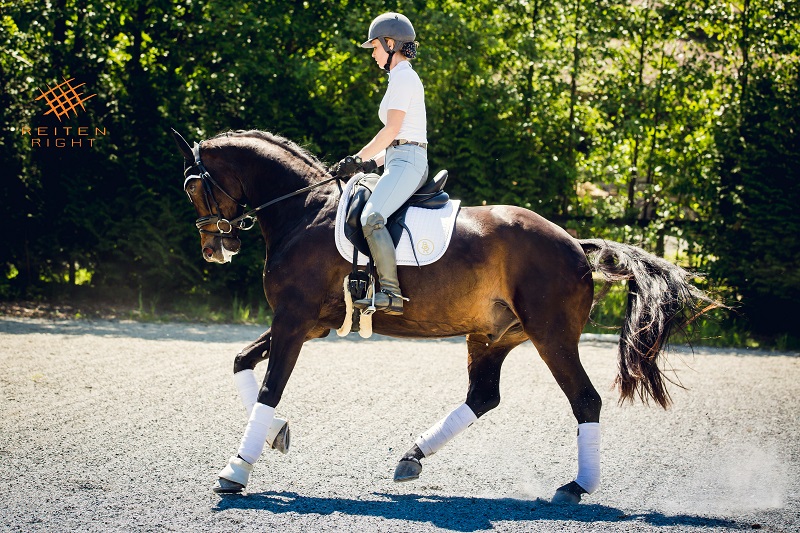
Choose an arena location that promotes good drainage. An outdoor arena should be crowned with a one to three percent grade and should work with the natural slope of the terrain. Photos: ReitenRight
“We want to use natural sand with grains which are sub-angular,” said Eric Porter, director of sales and technical services, Fairmount Santrol-Lakeshore Sand Co. “We do not want round sand grains because they will not lock together and we do not want to use manufactured or crushed quartz type sand. These grains are sharp and have stress cracks from the crushing process. These sand grains will continue to fracture creating dust and inhibit water flow through the footing.
Related: Get Your Horse on a Track System
“When we process the natural sand, which is typically mined in an open pit mine or from sand dunes, we like to have a wide range of grain sizes so the sand will have a consistent packed density. The coarse particles are removed by screening (and) one should be concerned about the long term supply of consistent sand as there will be some maintenance on the arena.”

Groom your arena frequently to keep your footing consistent. The more your arena is used, the more often you will need to groom it. Photo courtesy of Conterra Industries
Von Hauff cautioned against using washed sand. He said that as soon as it dries out it can displace and provide no traction.
“Your sand needs binding material in it and minor amounts of clay,” he said. “You want irregular shaped sand so that the particles link together. You don’t want round sand or river sand. It is round from tumbling (and) you get no locking effect. You want sand that has lots of angles and irregular edges and shapes so that they will bind together by friction.”
For the subsurface, Heaton recommends five to eight millimetres of medium to heavy screened sand with a 10 to 12 percent silt/clay content. The top dressing, as an extension of the subsurface, should be comprised of three to eight millimetres of medium to heavy screened sand with five to seven percent silt/clay content. Regarding washed sand Heaton, like von Hauff, said that it lacks the body and texture required to establish stable footing.
Related: Building an Environmentally Sound Outdoor Riding Ring
Heaton also noted that the density of the footing material needs to increase in relation to the amount of force exerted by the horse’s hoof in transition so attention should be paid to the type of discipline that will be ridden most frequently in the arena.
“At a nice light lope the horse may utilize only the top inch of footing,” said Heaton. “However, on an extremely hard turn or stop, the horse’s hoof may travel deep into the subsurface to find the stable footing required to make the transition.”
Clearly it is important to understand the physics of sand and the role it plays.
“People need to have somebody who understands about sands and how they react under different climatic circumstances,” said Christian Bauer, footing specialist and owner of IQ Footing in Malaga, Spain. “The footing layer is what gives traction and shock absorption.”
Bauer installs arenas for high level competitions worldwide as well as on private farms where owners want the safest footing.
Understanding the biomechanical impact of horses ridden on different surfaces has become an exact and ongoing science.
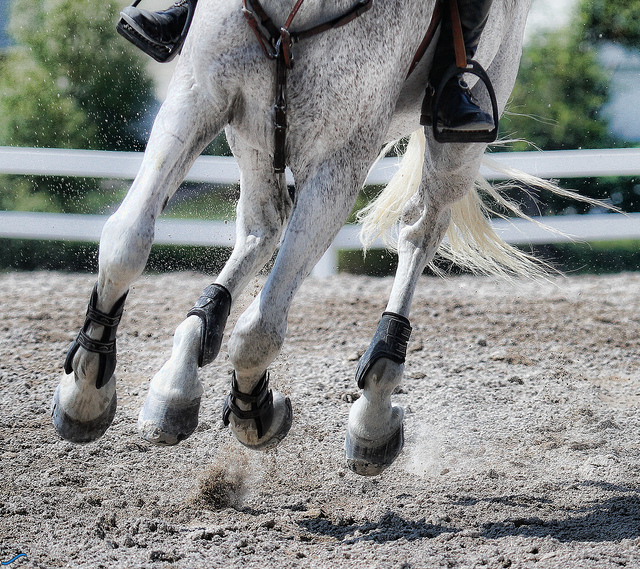
At a normal gallop, a 1,200-pound horse impacts the ground at 1,400 pounds per square inch. An inferior arena surface without proper shock absorption, cushioning, and traction puts a horse at risk of injury. Photo: Carterse/Flickr
“It is true to say that the majority of riders analyze their horse’s performance from a qualitative perspective almost every time they ride, and to some extent their perception provides a measure of the demands on their horse,” wrote Hobbs in the Equine Surfaces White Paper. “This type of information has been gathered through questionnaires to further our knowledge of rider preferences about surfaces but, since it is subjective, it can vary considerably between horse, rider, and situation. To obtain objective data, it is necessary to measure the horse performing on different surfaces. Research in this area is currently growing and includes the use of instrumented horseshoes to measure the forces at the ground, accelerometers to measure the amplitude and frequency of impact shock and how vibration decays, 2-D and 3-D kinematic techniques to measure differences in locomotion characteristics on different surfaces, and bespoke equipment to assess the difference in forelimb loads.”
She added that there are some innovative products on the market today, particularly those designed to manage moisture.
Related: Good Hoof, Bad Hoof
“The types of horses and activities should be a consideration when purchasing a surface,” said Hobbs. “When costs are a limitation it is very important to research the advantages and limitations of different surface types. All arenas should be laid on a uniform base. Often this is clean washed stone and if the arena is outdoors suitable drainage will also be required. Indoor arenas may or may not need to be drained, depending on the location. Where costs are not an issue the base may also include a moisture management system. Most surfaces should then have a membrane, usually a good grade geotextile membrane, that allows free drainage to occur, but does not allow the top surface to wash through.”
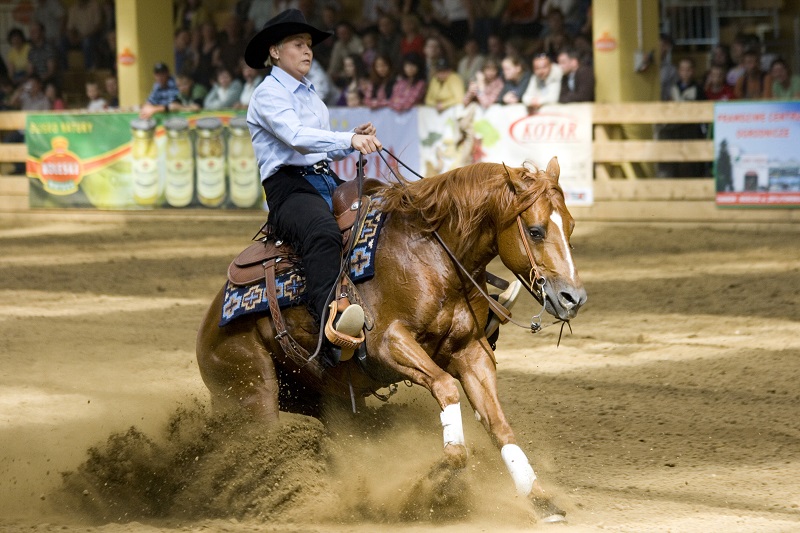
Footing should be designed around the types of activities that will be ridden in the arena most frequently. Photo: Dreamstime/Galantnie
Today, sand isn’t the only material for surface footing and people are looking at composites of materials with the primary needs for safety, traction, and moisture retention. Considering that a 1,200-pound horse impacts the ground at 1,400 pounds per square inch at a normal gallop, cushioning, shock absorption, and traction are vital. A surface below par puts a horse at risk of injury to ligaments, joints, or muscles.
“For a long time hog fuel was the best thing since sliced bread but now geotextile footings have come in,” said von Hauff. “There are products to cut down the amount of water needed for arenas. We’re researching it and expect to have a product out by April 2016.”
Textiles as additives to an arena surface can be a blend of non-toxic rubber, which creates cushioning and energy return, as well as fibre, which can add traction and stability. Capozzi said that they take into consideration a number of factors when suggesting a ratio of their product as an additive to an arena.
“We look at the size of the arena, the current footing system, current footing depth, discipline, volume of riders, and any problems or goals (people) have for their arenas,” she said.
According to Cynthia Brewster-Keating with the equestrian division of Polysols, Inc. (GGT Footing), in
Spartanburg, South Carolina, the golden rules for arena maintenance include regular removal of manure with a pitchfork and wheelbarrow, regular watering, daily grooming to keep the surface smooth, grading to maintain levels that ensure water runs away from the centre, and periodic checking of footing depth to assess the need for additional surface footing over time.
With the arena in place, safe riding will come down to consistent grooming.
“Never groom an arena when it’s dry,” said von Hauff. “You can damage the base. Only groom it when it’s damp or wet. And never ride on your footing when it is bone dry.”
He recommends putting in a sprinkler system as it will save water. Hoses waste a lot of water with leakage. Always moisten the arena in the evening or very early in the morning to conserve water content and in order to avoid evaporation from the heat of the day.
A properly constructed arena designed for the discipline of your choice is a wonderful addition to your property. But before starting, get lots of quotations, check out arenas built by contractors, look at arenas at other facilities, ask around and seek out the best contractor you can afford. Thoroughly research the top surface, additives, geotextiles, and the current trends toward surface composites that help retain moisture. Investigate grooming equipment, especially any that offer a depth control system. Your tractor will have a three-point hitch which will raise or lower your groomer but you want to ensure it sits level and that you can control the depth of the teeth. You want to gently groom the top layer, not rip up the subsurface or, worse, the base.
Investing in an arena is a serious financial commitment. Do it once and do it right. Because it’s not only about the footing… it’s about what lies beneath.
Related: Reduce the Risk of Exposure to Crystalline Silica Dust in Riding Arenas
Related: How Does Footing Affect Fitness in Horses?
Main photo: iStock/Anett SomogyvAlri



